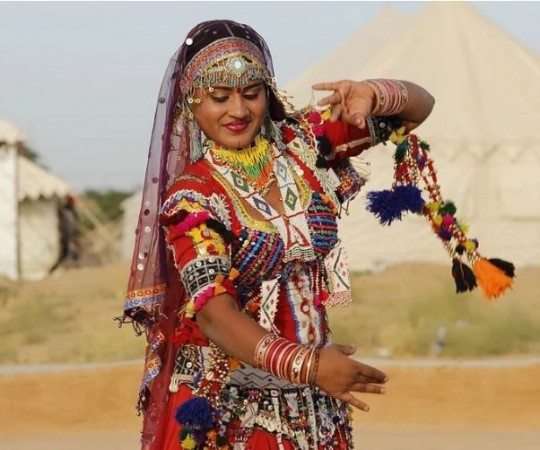
The princely state of India, Rajasthan is rich in culture and heritage. Not only the monuments and traditions date back to hundreds of ages, the traditional dance forms too along with evolving with age has maintained their charm thereby never failing to spellbind an onlooker be it within its own country or internationally. These folk dances reflect the vibrant history, customs, and traditions of the region. Often performed during festive occasions, weddings, and other celebratory events, these dances add color and exuberance to the lives of the people of Rajasthan. Each dance has its unique style, costumes, and musical accompaniment, making it an integral part of the state's cultural identity.
Also Read: The Ghost Lights of the Sundarbans: Unraveling an Eerie Mystery
Ghoomar: It is one of the most famous and elegant folk dances of Rajasthan. Performed by women, it derives its name from the twisting and swirling movements of the dancers. Dressed in bright, colorful traditional attire like ghaghra (long skirt) and odhni (scarf), the dancers gracefully move in a circular pattern while maintaining a delicate balance. The dance is accompanied by melodious folk songs that narrate stories of love, valor, and nature. Ghoomar is a symbol of femininity and a celebration of womanhood in Rajasthan.
Also Read: Cultural Heritage in Motion: The Stories and Traditions of Celebrations
Kalbelia: It is associated with the Kalbelia tribe, known for their expertise in snake charming. The dance emulates the graceful movements of a snake, with the performers wearing black swirling skirts and twirling to the rhythm of traditional musical instruments like the pungi (wooden flute) and dholak (percussion instrument). The Kalbelia dance has earned global recognition and is even inscribed on UNESCO's Representative List of the Intangible Cultural Heritage of Humanity.
Also Read: The Colorful Evolution of Indian Arts and Crafts: Yesterday, Today, and Tomorrow
Bhavai: It is a traditional form of entertainment that involves balancing acts performed by skilled male artists. They balance multiple pots or brass pitchers on their heads while dancing on a glass or thali (metal plate). The dance requires immense concentration, skill, and flexibility. The performance is accompanied by soul-stirring folk music and devotional songs. Bhavai was originally performed by the Bhavai community during fairs and festivals to entertain the masses.
Also Read: Celebrating India's Real-Life Heroes: Stories of Triumph and Valiance
Chari: It is an impressive dance form performed by the women of the Meena tribe. It involves balancing brass pots (chari) on their heads while holding lighted lamps inside them. The dance symbolizes the significance of water in the arid region of Rajasthan, where women would travel long distances to fetch water. The synchronized movements of the dancers, along with the glowing lamps, create a mesmerizing visual spectacle.
Also Read: Ancient Echoes to Modern Stages: Tracing the Evolution of Indian Theater
Ghudla: It is a spirited dance form performed by the Bhil tribe during special occasions. It is characterized by fast-paced footwork and the use of small sticks or dandiya (sticks) by the male dancers. The dancers form a circle and showcase their agility and vigor, accompanied by the energetic beats of traditional folk music and drumming.
Also Read: Exploring the Rich Cultural Heritage of Indian Folk Dances
Kathputli: It is a traditional puppet dance that dates back centuries. Puppeteers manipulate intricately designed wooden puppets adorned in traditional Rajasthani attire, telling stories from history, mythology, or daily life. The skilled puppeteers make the puppets dance to the tunes of traditional folk songs and narrate tales that amuse and enlighten the audience.
Also Read: Devotion in Harmony: Exploring Bhajans, Qawwalis, and Devotional Music in India
Fire Dance (Agni Nritya): It is also known as Agni Nritya, is an awe-inspiring dance performed by the Jasnathis, a community of snake charmers. Dancers perform breathtaking movements on a bed of burning coals, showcasing their devotion and fearlessness. It is believed that their faith and spiritual connection protect them from getting hurt during the performance.
Also Read: Enlightened Souls: Unraveling the Wisdom of Saints and Mahatmas
Gair: It is a captivating folk dance that involves men dancing in concentric circles, dressed in vibrant attire. The dancers use sticks while performing synchronized movements, showcasing their unity and coordination. The dance is usually performed during festivals like Holi and Janmashtami and is a delight to watch.
Rajasthan's folk dances are a reflection of the state's rich cultural heritage, deep-rooted traditions, and vibrant history. They preserve the essence of the land and its people, and through these dances, the performers pass down the stories of their ancestors from one generation to another. These dances not only entertain but also provide a glimpse into the beliefs, values, and lifestyle of the people of Rajasthan. They remain an essential part of the state's cultural identity and continue to enthrall audiences from across the world, fostering a sense of pride and unity among the people of Rajasthan.
Also Read: Crafting Stories: The Art of Indian Handicrafts and Textiles
Connecting with the Divine: The Power of Deity Worship in Human Lives